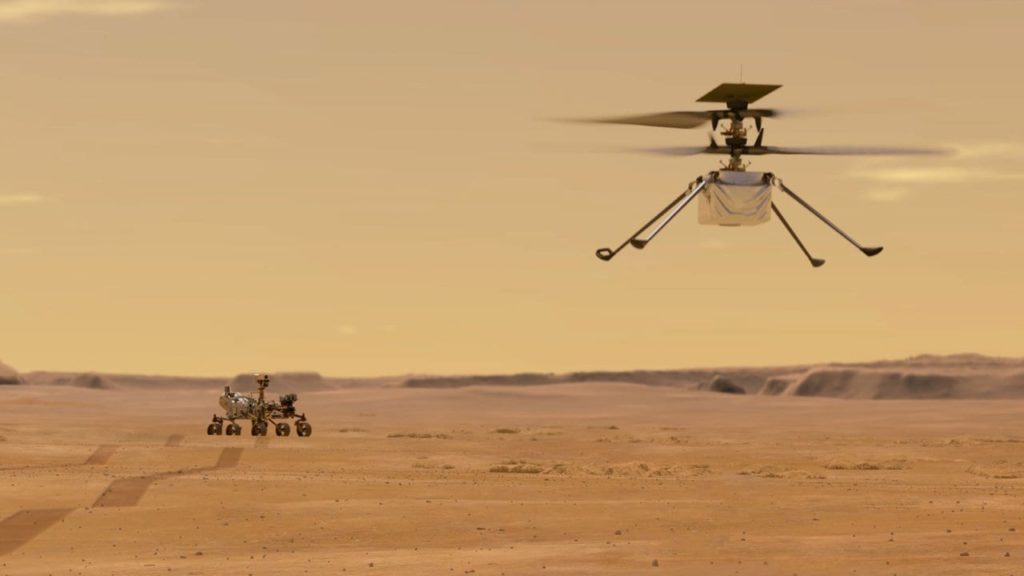NASA’s Perseverance rover is carrying a special passenger with it. Ingenuity Mars Helicopter will travel with the Perseverance rover through 505 million kilometres of interplanetary space to get to Mars.
When the rover lands on mars at Jezero crater in February 2021. Ingenuity will be deployed about two months after Perseverance lands on Feb. 18, 2021.
That to be around the 60th Martian day or SOL, of the mission Perseverance will drop the Mars Helicopter Delivery System’s graphite composite debris shield that protected the helicopter during landing. Then it will drive into the center of the chosen airfield.

About six days later, after the helicopter and rover teams are satisfied everything is go, they’ll command Mars Helicopter Delivery System to do its thing. “Ingenuity is unlike any other helicopter ever built because powered controlled flight at Mars is unlike anything ever attempted,” said MiMi Aung, project manager of the Mars Helicopter at NASA’s JPL Pasadena. “And then we had to figure out how to hitch a ride and safely get deployed from the Mars 2020 Perseverance rover.”
Before all this happens, the rovers should survive the 7 minutes of terror. You can read more that here.
Mars Helicopter Size
Ingenuity’s square fuselage (which houses most of the system required for the flights) is about the size of a softball. But if you look outside the box, you’ll find a lot of other important stuff including an antenna, solar panel, landing legs and two rotors measuring 1.2 meters across that makes stowing and deploying the helicopter a challenge. The entire package tips the scales at about 2 kilograms and its around 49 centimeters tall.
Before getting deep into the details of Mars 2020 rover let’s check the general facts about Ingenuity.
Key Facts of Mars Helicopter
Name: Ingenuity
Also known as: Mars Helicopter
Job: An innovation show to test the first flight on Martian land. The helicopter will ride to Mars connected to the belly of the Perseverance rover.
Mission Length: 1 or more flights in a period of 30days after the rover deploys the Helicopter.
How the job is done?
During early stages of surface operations both the rover and helicopter teams will be on the lookout for potential airfields 10-by-10-meter patch of Martian real estate that is comparatively flat, level, obstruction-free and viewable by Perseverance when the rover is parked about a football field away.
The deployment process begins with the rover releases a locking mechanism that holds the helicopter in place. Then a cable-cutting pyrotechnic device fires, allowing a spring-loaded arm that holds the helicopter to begin rotating Ingenuity out of its horizontal position. Along the way, a small electric motor will pull the arm until it latches, bringing the helicopter body completely vertical with two of its spring-loaded landing legs deployed. Then other two legs are released releasing the other legs.
“And all the while, the deployment system has to maintain electrical and data cable connections between rover and helicopter until it’s ready to drop,” said David Buecher, deployment system manager at Lockheed Martin Space in Denver, which built the system.
When is first flight
If everything goes as plan, mission controller will command the delivery system to release of the helicopter from the belly of the rover, once a good drop is confirmed, Perseverance will be commanded to drive away so the helicopter can begin recharging its batteries with its solar panel. At that point, the 30 SOL clock on Ingenuity’s flight test program begins.
Key Objectives
1. First test of powered flight on another planet.
2. Built to be light and strong enough to stow away under the rover while on the way to Mars, and survive the harsh Martian environment after arriving on the surface. The helicopter weighs less than 1.8 kilograms.
3. Powerful enough to lift off in the thin Mars atmosphere. The atmosphere of Mars is very thin: less than 1% the density of Earth’s.
4. The helicopter may fly for up to 90 seconds, to distances of almost 300 meters at a time and about 10 to 15 feet from the ground.
5. The helicopter flies on its own, without human control. It must take off, fly, and land, with minimal commands from Earth sent in advance.
Additional Resources:
